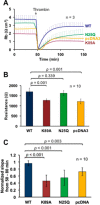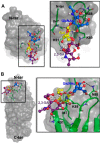The Role of Sialylated Glycans in Human Platelet Endothelial Cell Adhesion Molecule 1 (PECAM-1)-mediated Trans Homophilic Interactions and Endothelial Cell Barrier Function
- PMID: 27793989
- PMCID: PMC5207088
- DOI: 10.1074/jbc.M116.756502
The Role of Sialylated Glycans in Human Platelet Endothelial Cell Adhesion Molecule 1 (PECAM-1)-mediated Trans Homophilic Interactions and Endothelial Cell Barrier Function
Abstract
Platelet Endothelial Cell Adhesion Molecule 1 (PECAM-1) is a major component of the endothelial cell intercellular junction. Previous studies have shown that PECAM-1 homophilic interactions, mediated by amino-terminal immunoglobulin homology domain 1, contribute to maintenance of the vascular permeability barrier and to its re-establishment following inflammatory or thrombotic insult. PECAM-1 glycans account for ∼30% of its molecular mass, and the newly solved crystal structure of human PECAM-1 immunoglobulin homology domain 1 reveals that a glycan emanating from the asparagine residue at position 25 (Asn-25) is located within the trans homophilic-binding interface, suggesting a role for an Asn-25-associated glycan in PECAM-1 homophilic interactions. In support of this possibility, unbiased molecular docking studies revealed that negatively charged α2,3 sialic acid moieties bind tightly to a groove within the PECAM-1 homophilic interface in an orientation that favors the formation of an electrostatic bridge with positively charged Lys-89, mutation of which has been shown previously to disrupt PECAM-1-mediated homophilic binding. To verify the contribution of the Asn-25 glycan to endothelial barrier function, we generated an N25Q mutant form of PECAM-1 that is not glycosylated at this position and examined its ability to contribute to vascular integrity in endothelial cell-like REN cells. Confocal microscopy showed that although N25Q PECAM-1 concentrates normally at cell-cell junctions, the ability of this mutant form of PECAM-1 to support re-establishment of a permeability barrier following disruption with thrombin was significantly compromised. Taken together, these data suggest that a sialic acid-containing glycan emanating from Asn-25 reinforces dynamic endothelial cell-cell interactions by stabilizing the PECAM-1 homophilic binding interface.
Keywords: adhesion; endothelial cell; glycosylation; permeability; platelet endothelial cell adhesion molecule (PECAM); sialic acid; vascular biology.
© 2016 by The American Society for Biochemistry and Molecular Biology, Inc.
Figures






Similar articles
-
Atomic Level Dissection of the Platelet Endothelial Cell Adhesion Molecule 1 (PECAM-1) Homophilic Binding Interface: Implications for Endothelial Cell Barrier Function.Arterioscler Thromb Vasc Biol. 2022 Feb;42(2):193-204. doi: 10.1161/ATVBAHA.121.316668. Epub 2021 Dec 23. Arterioscler Thromb Vasc Biol. 2022. PMID: 34937389 Free PMC article.
-
CRISPR-mediated deletion of the PECAM-1 cytoplasmic domain increases receptor lateral mobility and strengthens endothelial cell junctional integrity.Life Sci. 2018 Jan 15;193:186-193. doi: 10.1016/j.lfs.2017.11.002. Epub 2017 Nov 6. Life Sci. 2018. PMID: 29122551 Free PMC article.
-
Structural basis for PECAM-1 homophilic binding.Blood. 2016 Feb 25;127(8):1052-61. doi: 10.1182/blood-2015-07-660092. Epub 2015 Dec 23. Blood. 2016. PMID: 26702061 Free PMC article.
-
PECAM-1: regulator of endothelial junctional integrity.Cell Tissue Res. 2014 Mar;355(3):607-19. doi: 10.1007/s00441-013-1779-3. Epub 2014 Jan 17. Cell Tissue Res. 2014. PMID: 24435645 Free PMC article. Review.
-
Endothelial functions of platelet/endothelial cell adhesion molecule-1 (CD31).Curr Opin Hematol. 2016 May;23(3):253-9. doi: 10.1097/MOH.0000000000000239. Curr Opin Hematol. 2016. PMID: 27055047 Free PMC article. Review.
Cited by
-
Dissecting the defects in the neonatal CD8+ T-cell response.J Leukoc Biol. 2019 Nov;106(5):1051-1061. doi: 10.1002/JLB.5RU0319-105R. Epub 2019 Jul 1. J Leukoc Biol. 2019. PMID: 31260598 Free PMC article. Review.
-
Switching of RNA splicing regulators in immature neuroblasts during adult neurogenesis.Elife. 2024 Nov 22;12:RP87083. doi: 10.7554/eLife.87083. Elife. 2024. PMID: 39576691 Free PMC article.
-
Involvement of TIMP-1 in PECAM-1-mediated tumor dissemination.Int J Oncol. 2018 Aug;53(2):488-502. doi: 10.3892/ijo.2018.4422. Epub 2018 May 25. Int J Oncol. 2018. PMID: 29845213 Free PMC article.
-
Glycans and Glycan-Binding Proteins as Regulators and Potential Targets in Leukocyte Recruitment.Front Cell Dev Biol. 2021 Feb 4;9:624082. doi: 10.3389/fcell.2021.624082. eCollection 2021. Front Cell Dev Biol. 2021. PMID: 33614653 Free PMC article. Review.
-
Platelet Endothelial Cell Adhesion Molecule-1 and Oligodendrogenesis: Significance in Alcohol Use Disorders.Brain Sci. 2017 Oct 16;7(10):131. doi: 10.3390/brainsci7100131. Brain Sci. 2017. PMID: 29035306 Free PMC article. Review.
References
-
- Newman P. J., Berndt M. C., Gorski J., White G. C. 2nd, Lyman S., Paddock C., and Muller W. A. (1990) PECAM-1 (CD31) cloning and relation to adhesion molecules of the immunoglobulin gene superfamily. Science 247, 1219–1222 - PubMed
-
- Newman P. J., and Newman D. K. (2003) Signal transduction pathways mediated by PECAM-1: new roles for an old molecule in platelet and vascular cell biology. Arterioscler. Thromb. Vasc. Biol. 23, 953–964 - PubMed
-
- Sun Q.-H., DeLisser H. M., Zukowski M. M., Paddock C., Albelda S. M., and Newman P. J. (1996) Individually distinct Ig homology domains in PECAM-1 regulate homophilic binding and modulate receptor affinity. J. Biol. Chem. 271, 11090–11098 - PubMed
MeSH terms
Substances
Associated data
- Actions
- Actions
- Actions
Grants and funding
LinkOut - more resources
Full Text Sources
Other Literature Sources
Molecular Biology Databases
Miscellaneous

